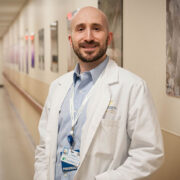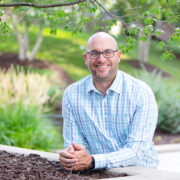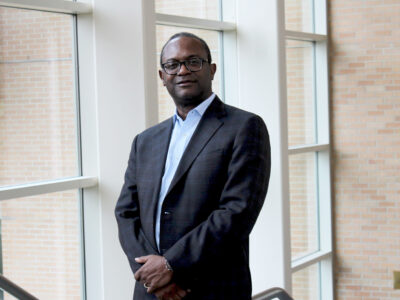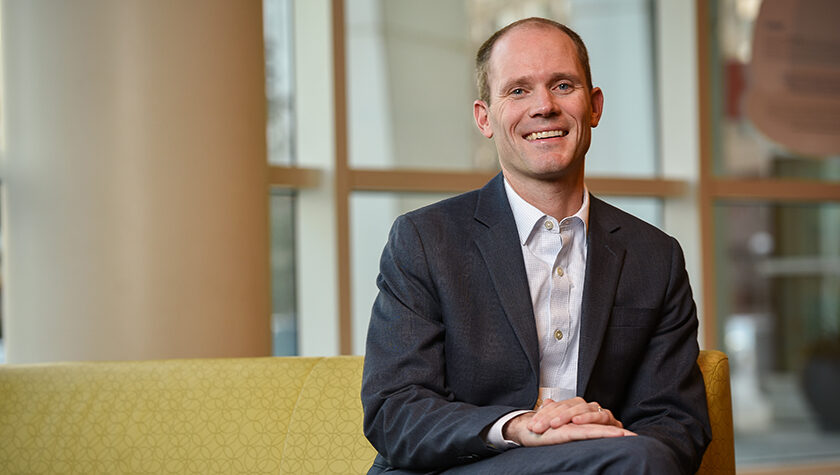
30
November

Through developing clinical guidance, alum Lee Skrupky broadly influences a breadth of interprofessional practitioners and patients
By Katie Ginder-Vogel
In the medical field, time is of the essence when pursuing the five “rights” of medication use: the right patient, the right drug, the right time, the right dose, and the right route.
To help patients receive the care they need quickly, and to avoid unnecessary tests and ineffective treatments, health systems create clinical practice guidelines that facilitate efficient diagnosis, treatment, and management of diseases.
National medical associations have established many clinical guidelines, but they aren’t comprehensive and leave room for health systems, practitioners, and researchers — like Lee Skrupky (PharmD ’05) — to create their own.
“The fun part is landing on an approach we feel optimizes the balance of priorities for patients we’re serving,” says Skrupky, clinical practice guideline author for the UW Center for Clinical Knowledge Management. “No matter the role, for me, fulfillment comes from working as part of a team to ensure patients are getting the most effective and safest care that reflects the best evidence.”
“No matter the role, for me, fulfillment comes from working as part of a team to ensure patients are getting the most effective and safest care that reflects the best evidence.”
—Lee Skrupky
As a clinical practice guideline author, Skrupky works with interdisciplinary teams to develop guidance that influences a range of practitioners and patients, neonatal to adult and inpatient to ambulatory.
“This role requires a sound clinical background; the ability to systematically review, analyze, and synthesize primary literature; and effective teamwork with all disciplines to help guide toward consensus recommendations that are evidence-based,” says Skrupky. “These very skills are often strengths that clinical pharmacists develop throughout their training and practice experience. As pharmacists, we are also noted to dot the i’s and cross the t’s, and that is often recognized by our colleagues.”
Developing clinical guidelines
Skrupky approaches the creation and implementation of clinical guidelines in different ways: endorsing published guidelines, creating new ones, and regularly reviewing and updating existing guidance.
In many cases, he and his team endorse and adopt recommendations from existing published guidelines after assessing that the evidence and methodology behind the recommendation are sound. But when there’s a dearth of guidance or evidence, Skrupky assembles interdisciplinary teams to dig in.
“When there are not established guidelines, we do an exhaustive literature review and evaluate evidence to support the guideline recommendations we develop,” says Skrupky.
Some examples that illustrate the scope the guidelines may cover include neonatal hypoxic-ischemic encephalopathy, Clostridium difficile infection, diabetes, medications for opioid use disorder, and the selection of venous access devices, which Skrupky just created for pediatric patients and is now working on for adult patients.
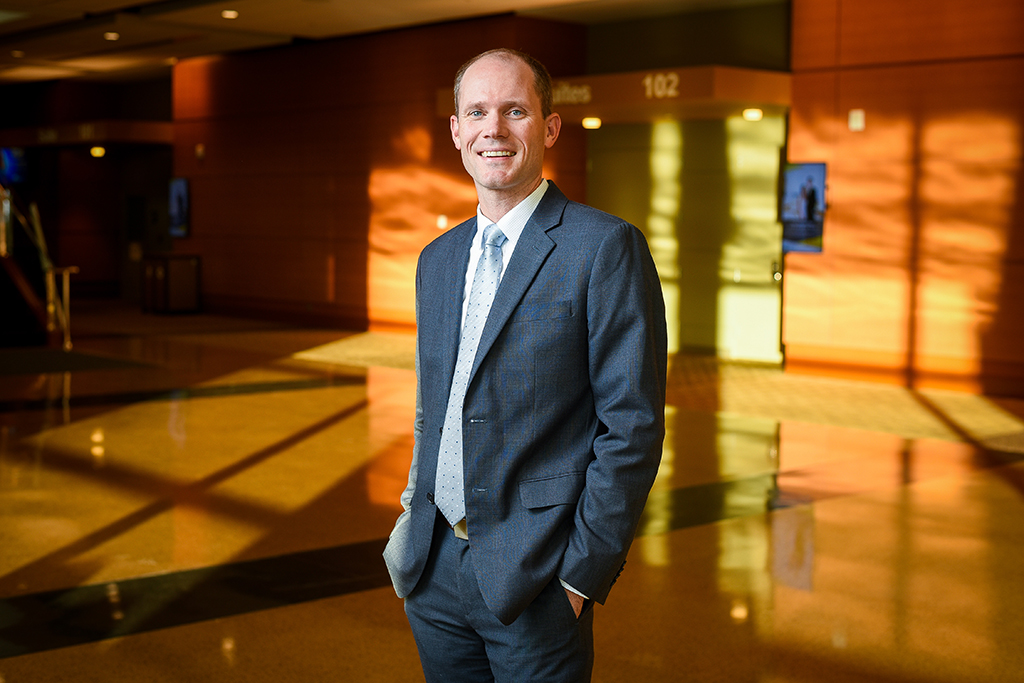
“Day-to-day, I work on several projects at once, each at different stages,” Skrupky says.
Skrupky begins the process of developing clinical guidelines with an intake process, in which he seeks to identify the guideline need, the project scope, the stakeholders and their priorities, and specific questions the guideline must address. The composition of his team will vary to ensure representation of key stakeholders and clinicians.
As projects get underway, next steps include background work, literature review, and research to clarify what is and is not already written or published. Each guideline has a champion — a clinician who comes forward to speak to a specific need for the guideline — and those champions remain engaged throughout the entire guideline development process.
Once the team categorizes a specific guideline, they grade the evidence, develop recommendations, determine which content and tools to include, and create that content, which closely involves the guideline champion and other stakeholders. They identify who needs to be involved in content development discussions, and the broader group does a larger review.
“It’s a weeks-long process of collecting feedback, making edits, and getting to the final product,” he says. “After that, commonly, we look to build tools or other resources to help implement and bring a guideline to life in clinical practice.”
All adopted guidelines are reviewed generally every three years, but that timeline can vary by the topic and frequency of changes in evidence or practice.
“To provide the best patient care — and this extends to direct and indirect patient care responsibilities — we have to be on top of the latest evidence and continually grow our knowledge base.”
—Lee Skrupky
“UW Health staff can also request a review or update at any time,” says Skrupky. “That way, if new evidence or guidelines pop up, we can triage them appropriately.”
Other healthcare professionals help manage guidelines of certain subject matter, such as pharmacists on the drug policy team that manage guidelines deemed to focus on medications and pharmacotherapy.
“We also have colleagues in nursing who focus on guidelines that are limited to nursing practice topics,” says Skrupky. “I, as a part of Center for Clinical Knowledge Management, manage the guidelines that are widely viewed as interdisciplinary in nature.”
Pursuing the cutting-edge
After graduating from the UW–Madison School of Pharmacy, Skrupky began his career as an ICU clinical pharmacy specialist following two years of residency at Barnes-Jewish Hospital in St. Louis, Mo., and the daily opportunity to positively influence care was very rewarding, he says.
“I led an effort to change our analgesia and sedation practices in the ICU, where you had to be an effective clinician, team member, and clinical researcher,” Skrupky says. “Ultimately, we were able to show that we improved our practices and patient outcomes.”
Even in this early step in his career, Skrupky embraced ongoing education as an important role in practice.
“To provide the best patient care — and this extends to direct and indirect patient care responsibilities — we have to be on top of the latest evidence and continually grow our knowledge base,” he says. “As a critical care specialist, I felt that was central to my role, and it didn’t stop at knowledge specific to medications. I found myself wanting and needing to learn more about all aspects of patient care, to understand the whole balance of a patient’s condition.”
Later in his career, as a clinical leader and residency program director at Aurora BayCare Medical Center in Green Bay, Wis., Skrupky led the development and implementation of antimicrobial stewardship efforts across multiple sites in the Aurora Healthcare system.
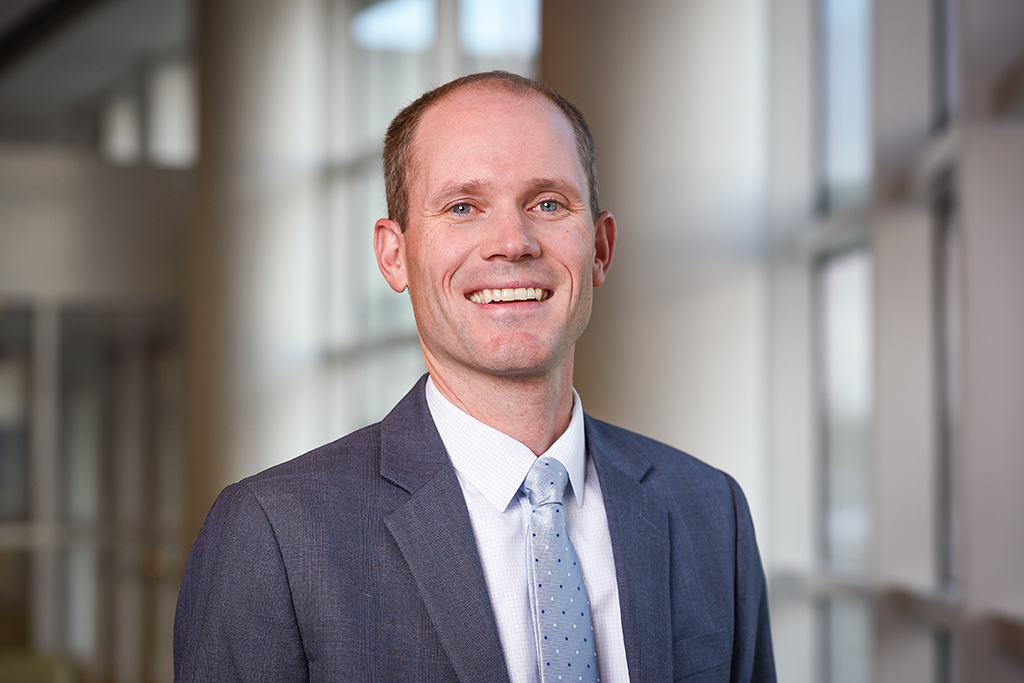
“I got to mentor younger pharmacists through that process and see others gain the confidence and skills to do the work of antimicrobial stewardship,” he says. “I know they’ll have careers doing that type of work and making meaningful impacts on patient care.”
Skrupky more recently served as pharmacy education manager at the Mayo Clinic in Rochester, Minn., for four years, until 2021. He spent much of that time developing and implementing an orientation and required education program that would meet the needs of new and existing pharmacy staff — pharmacists and pharmacy technicians across multiple sites and settings, including inpatient and ambulatory pharmacies.
“It was challenging and rewarding to successfully change how this was accomplished, to raise the bar, and to create bridges across sites and settings that hadn’t been quite as developed previously,” he says.
Along the way, Lee notes having been fortunate to work with many excellent colleagues and mentors that have helped him develop into an accomplished researcher and public speaker.
“The skills I’ve learned from successfully completing research projects and publishing our findings, as well as from developing and delivering talks on national stages, have paid dividends in every role I’ve held, in ways I couldn’t have predicted,” he says.
Finding a passion for learning
Skrupky says every educational and professional decision he’s made has been in consideration of both his work and his personal life.
“Healthcare was an early interest, and I had a good advisor at UW–Madison who suggested pharmacy and made a meaningful connection with faculty member Beth Elliot at the School of Pharmacy,” he recalls. “I quickly learned about the variety of roles that exist in our field, including opportunities to be clinically focused, which got me started on that pathway. I always believed pharmacy offered the opportunity to help people, as well as flexibility and job security, and I’m grateful that that has proven to be true.”
Skrupky enjoys direct patient care and has been able to keep a component of it in most of his professional roles. In fact, he was inducted as a Fellow of the American College of Critical Care Medicine (FCCM) by the Society of Critical Care Medicine in 2021, in recognition of his ongoing commitment to advancing practice.
“I always believed pharmacy offered the opportunity to help people, as well as flexibility and job security, and I’m grateful that that has proven to be true.”
—Lee Skrupky
“Transitioning away from direct patient care isn’t always easy — that’s true for many who make transitions where there’s less or no clinical time — but I think the more experience you gain, you learn more about how a department and even an institution operates, and you see there are opportunities to apply the skill sets, albeit in slightly different ways, to benefit patients and colleagues,” Skrupky says. “For me, that did lead to a desire to help lead clinical practice and education and training programs that exist in pharmacy. I have always loved to learn and grow in new areas, so I saw the opportunity to grow my leadership skills and have opportunities for mentorship.”
He’s grateful to have had training and faculty mentors at the School of Pharmacy — like former Associate Professor Beth Elliot, Associate Professor Karen Kopacek, Professor Beth Martin, and Associate Professor John Dopp — who provided him with a solid foundation from which to start. It’s what has made Skrupky’s multiple leaps to new areas of work surprisingly comfortable. The variety of roles available to pharmacists rely on pharmacy school training, and also, every new role requires the development of new skills.
“I credit the School and faculty for a wonderful education — critical thinking skills, building confidence, understanding how to navigate new situations,” Skrupky says. “I’m fortunate to have left there with confidence and a strong knowledge base. The more experience you gain, the more comfort you gain stepping into unfamiliar, uncomfortable areas and knowing you can navigate that new experience.”
And now that Skrupky is in a more advanced and highly collaborative stage of his career, he’s grateful for the chance to pay it forward.
“Getting to develop meaningful professional relationships within pharmacy and across disciplines and have opportunities to mentor our trainees and other pharmacy colleagues has been fulfilling,” he says. “I really cherish those times when organically you get to work with folks and help guide, mentor, and serve, as they decide how to navigate a project or where to go next in their careers.”


